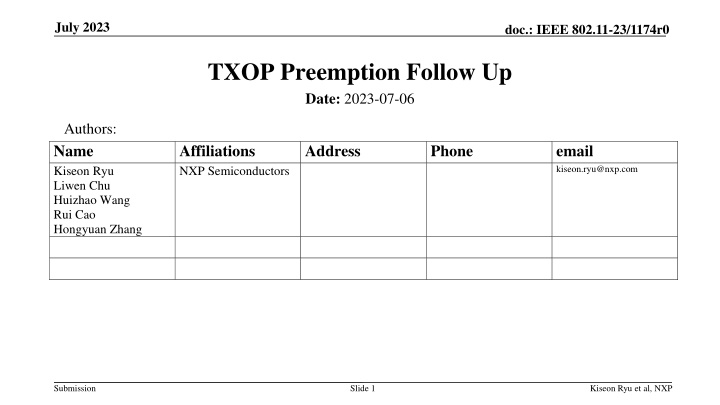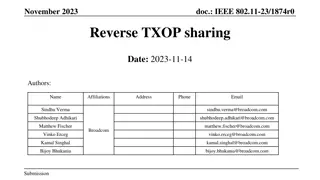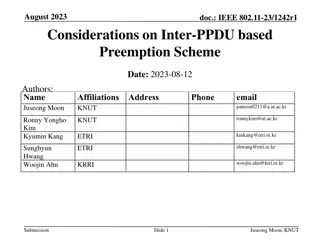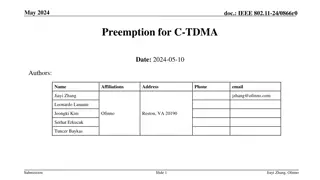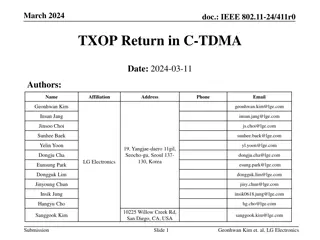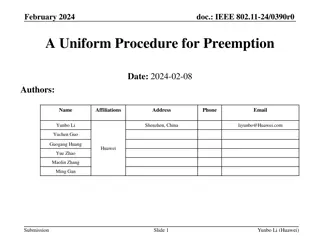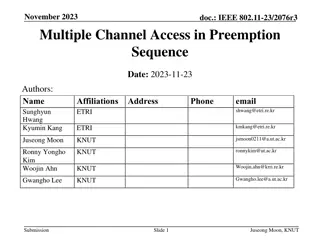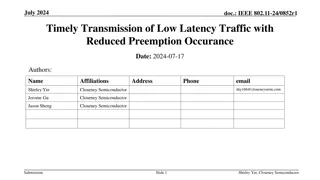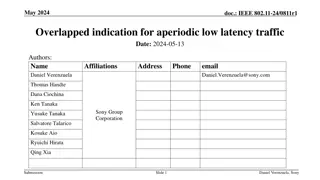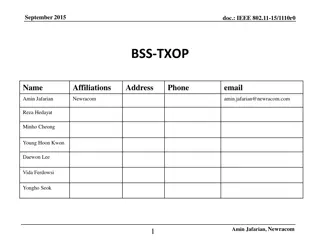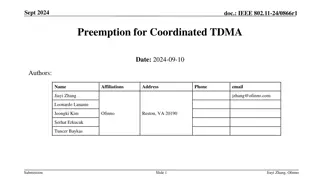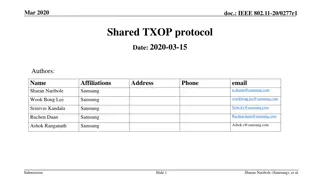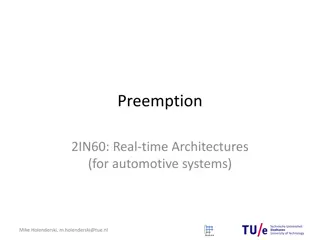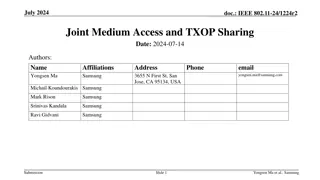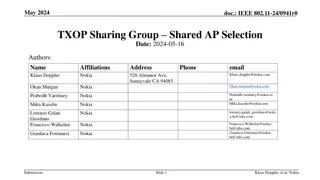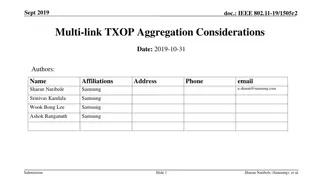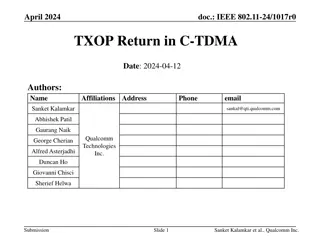IEEE 802.11-23/1174r0 TXOP Preemption Details
In this document, discussions on TXOP preemption as a low-latency traffic support feature in UHR networks are elaborated. Various possible cases and solutions, such as long PPDU transmission issues and DL low latency frame transmission challenges, are examined with potential resolutions put forward.
Download Presentation

Please find below an Image/Link to download the presentation.
The content on the website is provided AS IS for your information and personal use only. It may not be sold, licensed, or shared on other websites without obtaining consent from the author.If you encounter any issues during the download, it is possible that the publisher has removed the file from their server.
You are allowed to download the files provided on this website for personal or commercial use, subject to the condition that they are used lawfully. All files are the property of their respective owners.
The content on the website is provided AS IS for your information and personal use only. It may not be sold, licensed, or shared on other websites without obtaining consent from the author.
E N D
Presentation Transcript
July 2023 doc.: IEEE 802.11-23/1174r0 TXOP Preemption Follow Up Date: 2023-07-06 Authors: Name Kiseon Ryu Liwen Chu Huizhao Wang Rui Cao Hongyuan Zhang Affiliations NXP Semiconductors Address Phone email kiseon.ryu@nxp.com Submission Slide 1 Kiseon Ryu et al, NXP
July 2023 doc.: IEEE 802.11-23/1174r0 Introduction In [1] and [2], we discussed TXOP preemption as a candidate feature of UHR to support low latency traffic. In this document, we discuss further details of TXOP preemption Submission Slide 2 Kiseon Ryu et al, NXP
July 2023 doc.: IEEE 802.11-23/1174r0 Recap) TXOP Preemption Possible Cases [1] Case 1: DL low latency data TX in a UL TXOP TXOP responder (AP) needs to preempt the UL TXOP. Case 2: UL low latency data TX in a DL TXOP During a DL TXOP, an AP needs to transmit a Trigger frame for scheduling UL resource for UL low latency traffic STA1s TXOP APs TXOP LL data for STA2 LL data CTS BA TF- R M- BA Non-LL data RTS AP AP Non-LL data RTS CTS BA STA1 STA1 LL data for AP BA LL data STA2 STA2 Preempted TXOP Preempted TXOP Case 3: UL low latency data TX in a UL TXOP A TXOP holder (non-AP STA) needs to allocate a time period for an AP to schedule a UL resource for UL low latency traffic. Case 4: Low latency data TX in an OBSS TXOP Aggressive Spatial Reuse can be defined for an AP/non-AP STA to transmit a low latency frame during an OBSS TXOP. STA1s TXOP CTS BA OBSS AP TF- R M- BA CTS BA AP RTS Non-LL data OBSS STA Non-LL data RTS STA1 OBSS TXOP LL data LL data for AP LL data LL data AP or STA STA2 Preempted TXOP Submission Slide 3 Kiseon Ryu et al, NXP
July 2023 doc.: IEEE 802.11-23/1174r0 General Issue and Solution Issue: Long PPDU length Long PPDU transmission from a TXOP holder may forbid for a non-TXOP holder to preempt the TXOP with less delay As the PPDU length transmitted by the TXOP holder is longer, delay of the low latency packet becomes larger Less gain of TXOP preemption Potential solution An AP announces the maximal PPDU length through Beacon (Probe Response, Association Response etc.) that a non-AP STA can use. A non-AP STA in the BSS can t transmit a PPDU that is longer than the announced PPDU length. The restricted PPDU length can be applied to the PPDU of non-low latency traffic only or any PPDU. Submission Slide 4 Kiseon Ryu et al, NXP
July 2023 doc.: IEEE 802.11-23/1174r0 DL low latency frame transmission in the UL TXOP (Case 1) Assumption A non-AP STA is a TXOP holder. An AP is a TXOP responder, and the AP has a buffered low latency frame. Issue When the non-AP STA does not allocate a time period using RDG to the AP, the AP cannot transmit its buffered low latency frame before the end of the TXOP. SIFS SIFS SIFS SIFS SIFS SIFS SIFS SIFS C T S BA w/ PR LL data Pr. Rel DL LL data BA AP R T S UL PPDU UL PPDU STA1 Potential solution Option 1: The AP requests TXOP preemption in an immediate response frame (e.g., BA) to the TXOP holder and it transmits a low latency frame. After transmitting the low latency frame, the AP transmits a frame indicating TXOP Preemption Release to the TXOP holder. The TXOP holder can resume its transmission during the remaining TXOP. BA STA2 Option 1 SIFS SIFS SIFS SIFS SIFS SIFS SIFS PIFS C T S LL data Pr. Rel BA DL LL data Option 2: The TXOP holder transmits multiple PPDUs using a longer IFS (e.g., PIFS), and the TXOP responder may preempt the TXOP using a shorter IFS (e.g., SIFS) to transmit the low latency frame. A UL PPDU can include an indication of whether preemption is allowed after the UL PPDU. To avoid collision, only TXOP responder can preempt the TXOP during the UL TXOP. AP R T S UL PPDU UL PPDU UL PPDU STA1 w/ Ind. of preempt allowance w/ Ind. of preempt allowance BA STA2 Option 2 Submission Slide 5 Kiseon Ryu et al, NXP
July 2023 doc.: IEEE 802.11-23/1174r0 UL low latency frame transmission in the DL TXOP (Case 2) Assumption An AP is a TXOP holder. A non-AP STA (TXOP responder or non-TXOP responder) has a buffered low latency frame. Issue The AP is not aware of which non-AP STA has a buffered low latency frame. When and how the AP provides a preemption opportunity to a non-AP STA with low latency frame is the issue to be addressed. Potential solution A non-AP STA preempts the TXOP using a shorter IFS (e.g., SIFS) to transmit the low latency frame while an AP transmits multiple PPDUs using a longer IFS (e.g., PIFS). A DL PPDU can include an indication of whether preemption is allowed after the DL PPDU. To avoid collision from multiple non-AP STAs, a Low Latency Indication frame (w/ unified frame format such as e.g., a simultaneous CTS frame in response to an MU-RTS Trigger frame, etc.) can be transmitted to request UL resource allocation for low latency frame transmission. The AP that receives a Low Latency Indication frame can allocate UL resource for transmission of the low latency frame. SIFS SIFS SIFS SIFS SIFS SIFS PIFS SIFS SIFS R T S BS RP DL PPDU DL PPDU T F T F DL PPDU BA AP w/ Ind. of preempt allowance w/ Ind. of preempt allowance C T S BA STA1 L L I B S R LL data STA2 UL LL data Submission Slide 6 Kiseon Ryu et al, NXP
July 2023 doc.: IEEE 802.11-23/1174r0 UL low latency frame transmission in the UL TXOP (Case 3) Assumption A non-AP STA is a TXOP holder. Other non-AP STA has a buffered low latency frame. Issue The AP is not aware of which non-AP STA has a buffered low latency frame. How the TXOP holder provides a preemption opportunity to other non-AP STAs with low latency frame is the issue to be addressed. Potential solution For further study STA1s TXOP M- BA TF CTS BA AP Non-LL data RTS STA1 LL data for AP LL data STA2 Preempted TXOP Submission Slide 7 Kiseon Ryu et al, NXP
July 2023 doc.: IEEE 802.11-23/1174r0 Low latency frame transmission in the OBSS TXOP (Case 4) Assumption An OBSS STA is a TXOP holder. A non-AP STA or an AP has a buffered low latency frame. Issue Due to a non-zero basic NAV set by an OBSS frame, the AP/non-AP STA is not able to deliver the buffered low latency frame during the OBSS TXOP. Potential solution For further study CTS BA OBSS AP RTS Non-LL data OBSS STA OBSS TXOP LL data LL data AP or STA Submission Slide 8 Kiseon Ryu et al, NXP
July 2023 doc.: IEEE 802.11-23/1174r0 Summary For low latency frame transmission, the followings can be considered for TXOP preemption in UHR. A PPDU length can be limited in the TXOP. An AP can request preemption of the TXOP to a non-AP STA that is a TXOP holder. After a PPDU indicating preemption allowance, a low latency frame or a Low Latency Indication frame can be transmitted by a non-TXOP holder using a shorter IFS in a TXOP. Submission Slide 9 Kiseon Ryu et al, NXP
July 2023 doc.: IEEE 802.11-23/1174r0 References [1] IEEE 802.11-23/0018 Low latency support in UHR [2] IEEE 802.11-23/0092 Preemption Submission Slide 10 Kiseon Ryu et al, NXP
